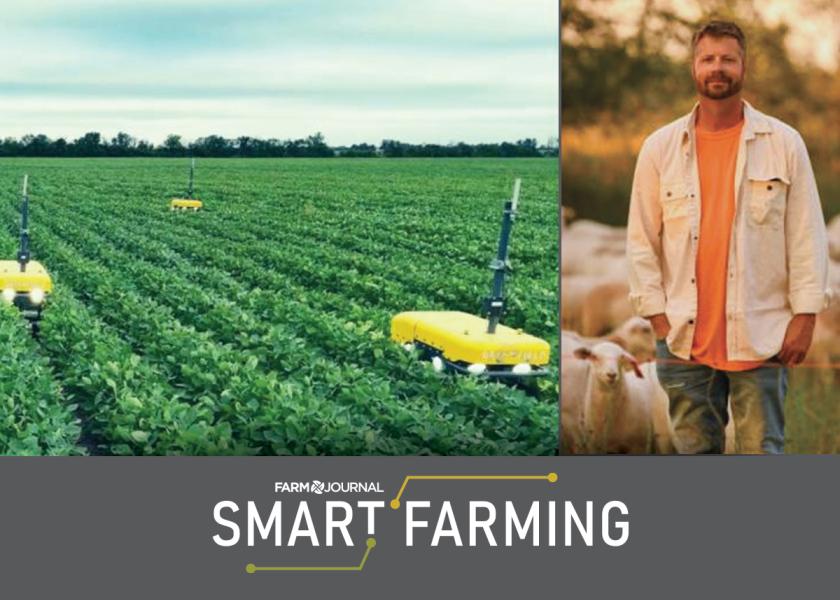Swarm To The Future? Mini Farm Robots With Big Plans

As part of our renewed effort to bring you the latest information on cutting edge technology and machinery we’re featuring regular Q&A discussions with several handpicked ag tech startups.
For this iteration, we’re connecting with GreenField Incorporated CEO Clint Brauer, a farm kid himself spawning innovations and ag tech jobs in his hometown of Cheney, Kansas. Brauer’s startup recently secured an undisclosed investment from Chipotle. Mid-Kansas Cooperative has also signed on to test out the swarmed, AI-powered mini-weeding and imaging robots.
The startup advocates chemical-free food production, at scale.
Farm Journal (FJ): How are herbicides eliminated by robots?
Clint Brauer (CB): Our robots eliminate most post-plant herbicides. Farmers still “burn down” and apply residual treatment pre-plant, but after that our robots handle the rest. The exception would be a grass infestation, but we have something coming for that. We typically run fields 1-3 times during a growing season. As we say to farmers, it’s a race to crop canopy. The bots don’t require a lot of power and more importantly, the weeds don’t develop genetic resistance to being cut down as they would to an herbicide.
FJ: Artificial Intelligence (AI) is cited as one of the technologies in play here. How or where does AI come into play specifically?
CB: AI can mean a lot of things. We use machine vision to recognize rows and objects in our field maps. Decisions are then made without human interference on how to path the robots around those fields and objects. Objects might be intersecting rows like concrete bunkers or telephone poles, etc. What’s going to be very interesting is the data we are gathering at near-ground level with these smaller machines…and what we can do with that data in the future to train various models.
FJ: Traditional row crop agriculture relies on large format/high horsepower machinery for field work, yet the Greenfield concept deploys small, connected fleets of robots that operate in concert to accomplish work at scale. Has this concept been proven yet or is there still work to do in convincing farmers?
CB: Traditional large format / high-horsepower machinery can only go over the tops of crops to spray herbicide while their tires crush 3% of the crop – or more. We are targeting 1% or less. So, it starts with that simple premise when we speak with farmers.
Beyond that, all farms face labor challenges. Just finding people can be difficult, but its even more difficult to trust someone in the cab of a $500,000-$1.5M machine both in the field…and sharing roads next to passenger vehicles. There’s no cab on our robots, hence they can work twenty hours a day.
FJ: What is the companies’ origin story?
CB: I am a third-generation farmer who established GreenField with a mission deeply rooted in personal experience. My father battled Parkinson's disease which we attribute to his long-term exposure to farm chemicals.
I wanted to come up with a solution that would prevent even one more person from going through that ordeal. This ignited my passion to explore many methods of farming including indoor growing, organic methods, tilled and no-till farming. I settled on regenerative farming without chemicals. But I realized that the technology required to implement this approach on a large scale was not available in the market. This gap in the agricultural sector led to the inception of GreenField, marking the beginning of our journey to revolutionize farming practices and eliminate chemicals in agriculture through swarms of small robots.
FJ: What made GreenField an ideal fit for Chipotle to invest in?
CB: I believe Chipotle appreciated GreenField’s vision for making regenerative farming more cost effective, efficient, and sustainable. Like Chipotle's commitment to cultivating a better world, we also believe in a future of real, responsible and sustainably-raised food. In partnership with Chipotle, we’ll continue to create innovative solutions in farming robotics to address some of the biggest challenges facing farmers across the United States.
FJ: What’s next at GreenField?
CB: One of our next goals is to eliminate the need for herbicide in broadacre agriculture completely. For years we have been developing something that eliminates all burn down and residual in the context of a regenerative, no-till farm. We think that will be almost all farms over the coming years. It’s just part of our continuous mission to create chemical-free food at scale and cultivate a better world, one robot at a time.
Learn more about GreenField and Brauer here, and be sure to check out Margy Eckelkamp's story on its partner Mid-Kansas Cooperative over at TheScoop.







